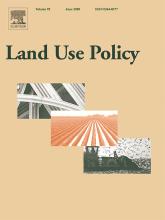Resource information
Formal regulation of private property and exploration of “risk transmission” across ownerships are two popular means for addressing wildfire management at landscape scales. However, existing studies also indicate that a number of barriers exist for implementing formal regulations surrounding wildfire risk, and that few efforts gauge influences on the resident support that serves as an important antecedent to implementation. Likewise, few studies of risk transmission incorporate social science literature to explore whether perceptions of wildfire sources influences support for regulatory approaches or performance of individual mitigations. The research presented here employed mixed-method, residential surveys of private property owners in Pend Oreille County, Washington, to explore potential influences on residents’ support for regulatory approaches for wildfire management on private properties, including perceptions of risk sources across the landscape and whether wildfire is a healthy component of the landscape. We also explore how the above factors, and other correlates such as part-time residency or proximity to neighboring properties, might influence the performance of private property mitigations across a range of rural properties in a larger landscape. Results suggest a low level of support for private property regulation for wildfire risk management and reduced wildfire response on properties where fewer personal mitigations are taking place. Consideration of wildfire risk sources and participation in collaborative actions or programs all had mixed effects, with perceptions of human ignitions on private lands correlating with support for property regulation and perceptions of human ignitions on public lands interacting with collaborative actions to correlate with higher levels of mitigation performance on individual properties. Results indicate that participation in wildfire actions and existing outreach programs were both relatively low in the landscape, and that engagement with such efforts do not significantly correlate with support for regulatory efforts. We conclude by comparing our findings to existing wildfire social science and suggesting future efforts or interpretations designed to advance a more nuanced view of the tradeoffs that private residents engage in when considering how their actions support landscape level wildfire management.


